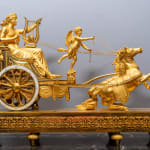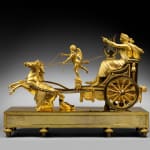
Jean-Dominique Augarde, "Les Ouvriers du Temps", 1996, p. 143, pl. 106, illustrating a clock of the same model by Deverberie, likewise of gilt bronze but slightly shorter in length and with the infant Mercury rather than Cupid, noted as from Galerie Gismondi, Paris.

Pierre Kjellberg, "Encyclopédie de la Pendule Française du Moyen Age au XXe Siècle", 1997, p. 416, pl. A, illustrating the same clock as that appearing in Augarde, op. cit.
Jean-Simon Deverberie 1764-1824
Further images
Literature
G. Wannenes, "Le Più Belle Pendole Francesi. Da Luigi XIV all'Impero", 1991, p. 174, illustrating a clock of the same model.
Jean-Dominique Augarde, "Les Ouvriers du Temps", 1996, p. 143, pl. 106, illustrating a clock of the same model by Deverberie, likewise of gilt bronze but slightly shorter in length and with the infant Mercury rather than Cupid, noted as from Galerie Gismondi, Paris.
Elke Niehüser, "Die Französische Bronzeuhr", 1997, p. 243, pl. 914, illustrating a clock of the same model but with the infant Mercury instead of the young Cupid.
Pierre Kjellberg, "Encyclopédie de la Pendule Française du Moyen Age au XXe Siècle", 1997, p. 416, pl. A, illustrating the same clock as that appearing in Augarde, op. cit.
Charlotte Vignon, "Deverberie & Cie: Drawings, Models, and Works in Bronze", in "Cleveland Studies in the History of Art", vol. 8, 2003, p. 186, listing clocks by Jean-Simon Deverberie featuring Apollo riding his chariot.
A rare and important Directoire gilt bronze chariot clock of eight day duration by Jean-Simon Deverberie, signed on the white enamel chapter ring between 6 o'clock Int et Fait par Deverberie/ Reu Barbet au Marais à Paris, with Arabic numerals and blued steel Breguet hands for the hours and minutes set within the wheel of a chariot which is cast at centre with twelve foliate and fluted spokes set at 5 minute intervals. The movement with anchor escapement, silk thread suspension, striking on the hour and half hour, with outside count wheel.
The magnificent case representing the figure of Apollo seated in his chariot holding upon his knee his lyre with its double serpent border, wearing a laurel leaf crown, Roman sandals and drapery around his loins that billows behind him, his golden chariot ornamented with laurel leaf borders and mounted with a female caryatid herm as well as eagle head on the arm rests and with hanging drapery below, with a lion head at the back of the chariot and at the prow the head of Marsyas mounted either side with a rosette, upon which stands on one foot the figure of the young winged Cupid, holding a caduceus in his right hand and like Apollo, holding reins attached to a pair of horses that pull the chariot onward, each horse with a flowing mane and tail, wearing a lambrequin saddle cloth and yoked by a Vitruvian scroll decorated harness as it rears on its hind legs while setting across the skies, the chariot and horses on a rectangular plinth with a frieze cast with acanthus scrolls issuing fruit and foliage, supported on eight toupie feet
Paris, date circa 1800
Height 60 cm, length 80 cm, depth 25 cm.
This truly magnificent chariot clock or pendule au char was made by Jean-Simon Deverberie (1764-1824), who worked in Paris initially from rue Barbet au Marais (sometime spelled Barbette on other of his dials) and was the maker of another almost identical clock (illustrated in Augarde and Kjellberg op. cit.). The signature on the latter clock reads: Inv. et fait par Deverberie rue Barbet au Marais, Paris and thus very slightly varies with the present signature but like the very best of Deverberie's clocks it features his name and address. Likewise, there are slight variations between the present clock and that illustrated in Augarde; the main differences being that the present example is slightly larger and that Cupid stands in place of the infant Mercury. In her scholarly article, Charlotte Vignon, from Cleveland Museum of Art, (op. cit. p. 186) notes that a Deverberie clock with Apollo riding his chariot was sold at Galerie Georges Petit in Paris on 5th December 1930, lot 10 but whether that was the same as here is unknown. Vignon also lists a clock of the same description having been sold at Christie's New York on 13th June 1987, lot 73 and also at Galerie Köller, Zurich on 2nd November 1995, lot 4059.
In addition, a clock of almost the same model as this but without Deverberie's signature, made of gilt and patinated bronze and the figure of Mercury instead of Cupid, was sold at Sotheby's Paris 4th November 2015, lot 426. Despite the signature, it too was described as an important clock while mention was made in the catalogue that a design by Deverberie for the case was housed in the Bibliothèque Institut National d'Histoire de l'Art (INHA), Paris. Deverberie also designed a number of other pendules au charincluding one with Aphrodite and a pair of winged putti riding a chariot on the sea and another of Hera in her chariot, of which the original designs (illustrated Vignon, op. cit, p. 174, pls. 1.29 & 31, respectively) are now housed in the Bibliothèque INHA. Added to them, Deverberie made other chariot clocks such as one with Victory at the helm, signed on the dial ring Lépine place des Victoire, which was sold at Hôtel George V, Paris, 23rd June 1988, lot 115 as well as others with Cupid in the chariot, of which some were signed with Deverberie's name while others featured the name of the Parisian clockmakers Armingaud l'aîné and Chopin.
While the exact date of when Deverberie became a maître bronzier is unrecorded, we know that he was working as a caster in 1788 and that he married Marie Louise Verron but never had children. Charlotte Vignon's article notes that he may have been the same Deverberie who specialised as a watchcase maker and that after the abolition of the guilds in 1791, he opened a bronze casting and clock factory with Jean George Hertzog. Having been established at rue Barbet au Marais, Deverberie then moved to rue des Fossés du Temple where he ran the firm of Deverberie et Cie. The lifting of the guild regulations during the French Revolution allowed casters, who during the ancient règime were strictly limited to working in bronze, to now develop factories of their own. Deverberie was one such man who took advantage of this freedom so that now all stages of the bronze making process, from casting, gilding, assembly and retail could occur in one workshop. In this he proved highly successful since by 1803 his business was worth 104,000 francs and the previous year had sent goods worth 40,000 francs to the Leipzig fair.
Deverberie et Cie made a range of luxury bronze objects from chenets and fire grates to candelabra and chandeliers. However, clock cases were his speciality. Not all were fitted with his movements but included those supplied by the Imperial clockmakers Henri Lepaute and Lépine as well as Lemoine, Marc Sandoz, Dubuc (Dubucq) and others. At times Deverberie contracted part of the gilding to Jean Claude Herouard, Jean-Jacques Dubois and others and also bought in glass globe covers for his clock cases from the famous glass blower Jean-Baptiste Binet as well as marble from Gilles l'ainé. In contrast to a number of other major bronziers, Deverberie did not supply the Garde-Meuble direct though he may have done so through as intermediary. Rather he tended to cater for a private clientele and also sold his cases to other European clockmakers while others were destined for the Russian and Turkish export market.
Although Deverberie's chariot clocks continue to be among his most prized pieces, he is probably better known for his series of clock cases, known as pendules au nègre or pendules au bon sauvage, notably those portraying female personification of Africa or America, which as a subject epitomised late eighteenth century European society's fascination with the exotic, unadulterated and untamed natural world. As such they could be seen as representing a new mythological Golden Age as opposed to chariot clocks, which focused upon the mythology of the ancient classical world.
Chariot clocks were one of a number of ingenious clock cases that allowed the fullest opportunity for the sculptor and bronzier to express the brilliance of their craft. The earliest examples dated back to sixteenth century Germany while in France, some of the first models with rocaille style chariots were made during Louis XV's reign. However, it was not until the very end of the eighteenth and particular the early years of the nineteenth century, that this type of clock found true popularity, whose revival was largely inspired by Napoleon's triumphant entry into Paris following his victories in battle. All followed the same basic design with the clock dial set into the wheel of an ancient chariot carrying a mythological figure, especially a deity.
As a subject, Apollo - one of the twelve Olympian deities, was perfectly suited for such clocks since he also became associated with the sun-god Helios who daily drove his chariot across the skies. According to myth, his golden chariot, known as a quadriga was yoked to a team of four horses that pulled it across the heavens, though for artistic purposes it is here pulled by just two steeds. Again as here, Apollo was generally portrayed as a beautiful young man who wears a crown of laurel leaves which he was awarded for his achievements to the arts. He also holds a lyre, alluding to him being a patron of poetry, music and as a leader of the Muses. Interestingly his lyre is decorated with a pair of snakes which refer to Apollo's victory over the serpent Python which according to Ovid he slew with a thousand arrows; at the same time the snakes, with one head inside the other can be seen as a symbol of eternity. Other symbolic yet decorative elements include the arm rests, shaped as the head of an eagle, an ancient symbol of power and victory, which was represented on the standards of the Roman legions, while the lion at the back of the chariot was often associated with courage. These attributes of power, victory and courage were not only common to Apollo and the ancient classical Empires but also ones that the new French Republican government and subsequently Napoleon were keen to promote. At the prow of the chariot is the head of the satyr Marsyas, who was a follower of Bacchus and a skilful flute player. Enraged by Marsyas's outward pride in his musical ability, Apollo challenged him to a contest, with Apollo playing his lyre while Marsyas played his flute. The Muses judged Apollo the victor, after which he killed Marsyas. As noted on some Deverberie models the infant Mercury, messenger of the gods, stands upon Marsyas's head but here we see Cupid, mythological god of love who still holds Mercury's caduceus and ensures above all that Apollo's chariot is guided by love.







